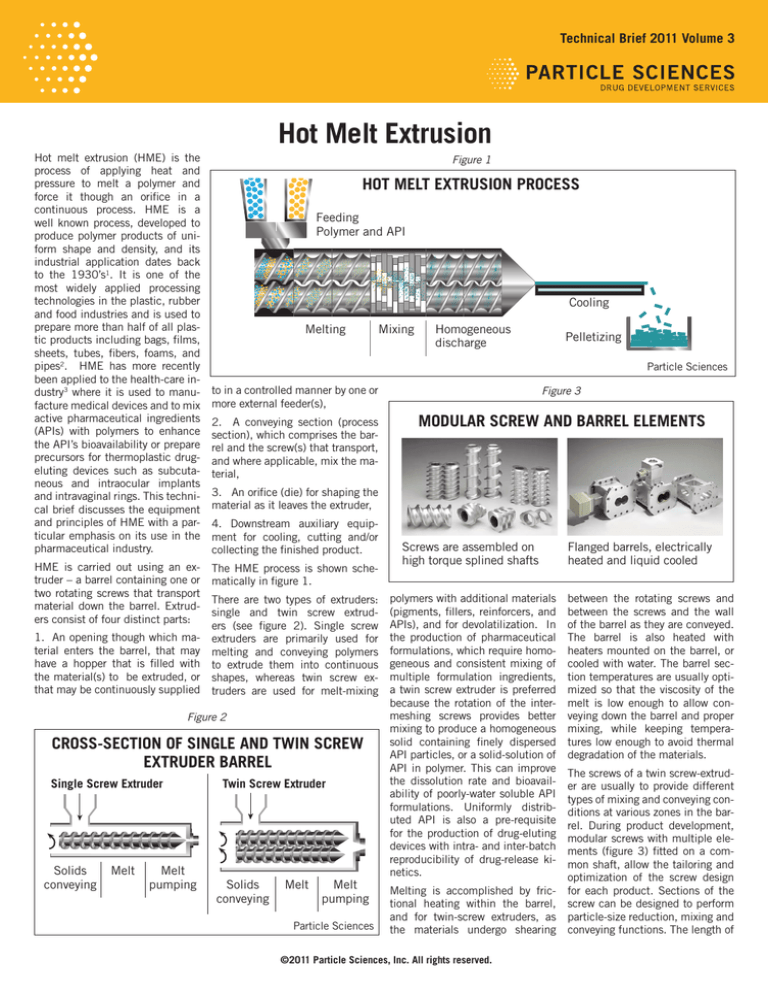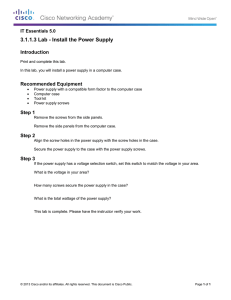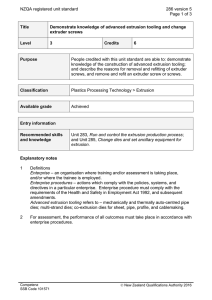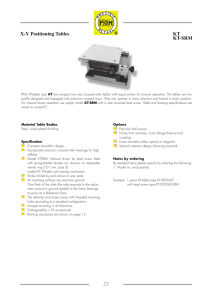
Technical Brief 2011 Volume 3
Hot Melt Extrusion
Hot melt extrusion (HME) is the
process of applying heat and
pressure to melt a polymer and
force it though an orifice in a
continuous process. HME is a
well known process, developed to
produce polymer products of uniform shape and density, and its
industrial application dates back
to the 1930’s1. It is one of the
most widely applied processing
technologies in the plastic, rubber
and food industries and is used to
prepare more than half of all plastic products including bags, films,
sheets, tubes, fibers, foams, and
pipes2. HME has more recently
been applied to the health-care industry3 where it is used to manufacture medical devices and to mix
active pharmaceutical ingredients
(APIs) with polymers to enhance
the API’s bioavailability or prepare
precursors for thermoplastic drugeluting devices such as subcutaneous and intraocular implants
and intravaginal rings. This technical brief discusses the equipment
and principles of HME with a particular emphasis on its use in the
pharmaceutical industry.
HME is carried out using an extruder – a barrel containing one or
two rotating screws that transport
material down the barrel. Extruders consist of four distinct parts:
1. An opening though which material enters the barrel, that may
have a hopper that is filled with
the material(s) to be extruded, or
that may be continuously supplied
Figure 1
HOT MELT EXTRUSION PROCESS
Feeding
Polymer and API
Cooling
Melting
to in a controlled manner by one or
more external feeder(s),
Melt
Melt
pumping
Pelletizing
Figure 3
Example
of extrusion
andAND
barrel
(right):
areELEMENTS
modular
of
extrusion
screwscrew
(left)(left)
and barrel
(right):
units units
are modular
2. A conveying section (process Example
MODULAR
SCREW
BARREL
section), which comprises the barrel and the screw(s) that transport,
and where applicable, mix the material,
3. An orifice (die) for shaping the
material as it leaves the extruder,
4. Downstream auxiliary equipment for cooling, cutting and/or
collecting the finished product.
The HME process is shown schematically in figure 1.
There are two types of extruders:
single and twin screw extruders (see figure 2). Single screw
extruders are primarily used for
melting and conveying polymers
to extrude them into continuous
shapes, whereas twin screw extruders are used for melt-mixing
CROSS-SECTION OF SINGLE AND TWIN SCREW
EXTRUDER BARREL
Solids
conveying
Homogeneous
discharge
Particle Sciences
Figure 2
Single Screw Extruder
Mixing
Twin Screw Extruder
Solids
conveying
Melt
Melt
pumping
Particle Sciences
Screws
are
assembled
on
Screws
are
onon
Screws
areassembled
assembled
high
torque
splined
shafts
high
torque
splined
shafts
high
torque
splined
shafts
polymers with additional materials
(pigments, fillers, reinforcers, and
APIs), and for devolatilization. In
the production of pharmaceutical
formulations, which require homogeneous and consistent mixing of
multiple formulation ingredients,
a twin screw extruder is preferred
because the rotation of the intermeshing screws provides better
mixing to produce a homogeneous
solid containing finely dispersed
API particles, or a solid-solution of
API in polymer. This can improve
the dissolution rate and bioavailability of poorly-water soluble API
formulations. Uniformly distributed API is also a pre-requisite
for the production of drug-eluting
devices with intra- and inter-batch
reproducibility of drug-release kinetics.
Melting is accomplished by frictional heating within the barrel,
and for twin-screw extruders, as
the materials undergo shearing
©2011 Particle Sciences, Inc. All rights reserved.
Flanged
barrels,
electrically
Flanged
barrels,
electrically
Flanged
barrels,
electrically
heated
liquid
cooled
heated
and and
liquid
cooled
heated
and
liquid
cooled
between the rotating screws and
between the screws and the wall
of the barrel as they are conveyed.
The barrel is also heated with
heaters mounted on the barrel, or
cooled with water. The barrel section temperatures are usually optimized so that the viscosity of the
melt is low enough to allow conveying down the barrel and proper
mixing, while keeping temperatures low enough to avoid thermal
degradation of the materials.
The screws of a twin screw-extruder are usually to provide different
types of mixing and conveying conditions at various zones in the barrel. During product development,
modular screws with multiple elements (figure 3) fitted on a common shaft, allow the tailoring and
optimization of the screw design
for each product. Sections of the
screw can be designed to perform
particle-size reduction, mixing and
conveying functions. The length of
the screw in relation to the barrel
diameter (the L/D ratio) is chosen
to optimize the degree of mixing
and the number of zones required
to achieve the final product characteristics. An example of a complete modular screw is show in
figure 4. Single-piece production
screws may be built to the same
design as the development screws,
but are easier to clean for cGMP
compliance.
Rotation of the screws creates
distributive and dispersive mixing (figure 5). Distributive mixing maximizes the division and
recombination of the materials
while minimizing energy input by
mixing with low extensional and
planar-shear effects. This uniformly blends the materials but does
not significantly reduce dispersed
material particle size and yields
minimal thermal and shear degradation of sensitive materials.
Dispersive mixing applies extensional and planar shear fields to
break the dispersed materials to
smaller size, ideally using energy
at or slightly above the threshold
level needed to break them down.
The use of different mixing elements allows the twin screw extruder to perform both particlesize reduction and mixing so that
the APIs can be incorporated into
the polymer in dispersed form or,
if the API solubility in the polymer
is high enough, in dissolved form.
Since the extrudate cools rapidly
on exiting the extruder, any API
that is dissolved in the polymer
at the mixing temperature may be
unable to recrystallize on cooling,
leading to supersaturated solid
solutions. In such cases stability of the product must be closely
followed as recrystallization of the
API over long time-scales is possible, especially at elevated storage
temperatures and high API loadings, and may impact the shelf life
of the final product.
There are two families of twin
screw extruders: high-speed energy input (HSEI) twin-screw extruders, which are primarily used
for compounding, reactive processing and/or devolatilization,
and low-speed late fusion (LSLF)
twin-screw extruders, designed
to mix at low shear and pump at
uniform pressures. Screws may be
senoz suoirav eht gniwohs redurtxFigure
e werc4s niwt a rof ngised wercs fo elpmaxe enO
)tfel eht ta degrahcsid si dnuopmoc dna thgir eht ta swercs eht retne slairetam(
VARIOUS MIXING ZONES OF COMPLETE MODULAR SCREWS
gniyevnoc diloS
Solid conveying
xim & tleM
Melt & mix
co-rotating (self-wiping), or counterrotating (calendar gap), see figure
6, with most extruders used for mixing being co-rotating.
Different types of exit dies are used
to shape the extrudate to the desired profile. These dies include
sheet and film dies used in transdermal film applications, strand
dies used for medical tubing and
some drug-eluting devices, shape
dies used in blow moulding, and coextrusion dies used in reservoir device designs. Different downstream
auxiliary components are also used
in the finishing process, including
water baths and air knives for cooling, conveyor belts for moving the
extruded product from the die to
the end of the line, strand-cutters
for cutting the extrudate into tubing
or rods, and spoolers for extrudate
collection. Pelletizers are used for
cutting the extrudate into smaller
pieces for direct capsule filling and
in the case of some devices for injection molding to form the final
product.
Figure 5
EXAMPLE OF
MIXING ELEMENTS
Broad
yevnoC
Convey Mix
Devolatilize
ezilitalov-eD egrahcsiD
Discharge
As with any dosage form, material
selection is critical in the development of a successful product. For
most applications, the polymer
should be thermoplastic, stable
at the temperatures used in the
process, and chemically compatible with the API during extrusion.
For solid oral dosage forms, water
soluble polymers are usually chosen from among polymers already
used in pharmaceutical products
such as poly(ethylene glycol) and
poly(vinylpyrrolidinone). With the
increased interest in using HME
for pharmaceutical products, major polymer suppliers are also beginning to offer polymers specifically designed for pharmaceutical
applications. For drug-eluting devices, the polymers are generally
water-insoluble, and the majority
of products under development
use either ethylene vinyl acetate
copolymers (EVAs) or polyurethanes.
es and hence with the formation
of minimal process-related API
degradants. Antioxidants are often
included within the formulation,
and the short residence time in
the barrel (typically on the order
of minutes) also helps to minimize
thermal degradation especially
compared to batch mixing and
other compounding processes.
Figure 6
of medical devices, dissolving oral
dosage forms and drug-eluting
devices with a process option that
maximizes API mixing with polymer, while minimizing API degradation, and even opens the door to
products that cannot be prepared
by other means.
One strategy for controlling drug
elution kinetics from devices such
as intravaginal rings involves an
extension of the simple extrusion
technique. Simultaneous extrusion of a drug-loaded core strand
with a release-controlling polymer
sheath that encapsulates the core
in a single co-extrusion process
produces a two-layer core-sheath
strand. A specially designed extrusion head is fed by two perpendicular extruders – one supplying
the core composition, the other
supplying the sheath material.
The core-sheath strand is cut and
HME allows the API to be mixed the ends connected to make the
with the polymer under the mini- final device.
mum of shear and thermal stress- HME provides product developers
END VIEW OF
INTERMESHING
TWIN SCREWS
Co-rotating
References
1. Rauwendaal CH. Polymer
Extrusion, Hanser Publishers,
München (1986) 20-25.
Global pool capture
Counter-rotating
Narrow
Melt division (Distributive)
Particle Sciences
3894 Courtney St., Bethlehem, PA 18017-8920, USA
Particle Sciences
Phone: +1 610 861 4701
Fax: + 1 610 861 4702
Email: info@particlesciences.com
www.particlesciences.com
2. Kruder GA. Extrusion. In: Encyclopedia of Polymer Science
and Engineering Vol. 1, 2nd ed.
John Wiley & Sons Inc., New York
(1985) 571-631.
3. Crowley MM, Zhang F, Repka
MA, Thumma S, Upadhye SB,
Battu SK, McGinity JW, Martin C. Pharmaceutical Applications of Hot Melt Extrusion: Part
I. Drug Dev Ind Pharm (2007)
33(9):909-926.
Particle Sciences is a leading integrated
provider of formulation and analytic services
and both standard and nanotechnology
approaches to drug development and delivery.



